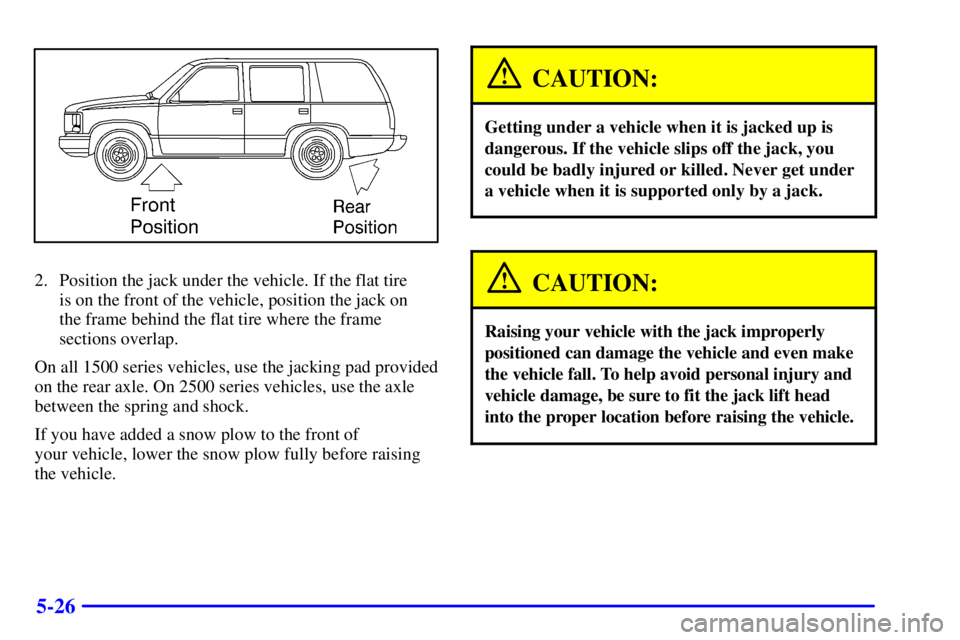GMC JIMMY 2001 Owner's Manual
Manufacturer: GMC, Model Year: 2001, Model line: JIMMY, Model: GMC JIMMY 2001Pages: 443, PDF Size: 2.97 MB
Page 301 of 443

5-18
Engine Fan Noise
Your vehicle has a clutched engine cooling fan. When
the clutch is engaged, the fan spins faster to provide
more air to cool the engine. In most everyday driving
conditions, the fan is spinning slower and the clutch is
not fully engaged. This improves fuel economy and
reduces fan noise. Under heavy vehicle loading, trailer
towing and/or high outside temperatures, the fan speed
increases as the clutch more fully engages. So you may
hear an increase in fan noise. This is normal and should
not be mistaken as the transmission slipping or making
extra shifts. It is merely the cooling system functioning
properly. The fan will slow down when additional
cooling is not required and the clutch disengages.
You may also hear this fan noise when you start
the engine. It will go away as the fan clutch
partially disengages.
If a Tire Goes Flat
It's unusual for a tire to ªblow outº while you're driving,
especially if you maintain your tires properly. If air goes
out of a tire, it's much more likely to leak out slowly.
But if you should ever have a ªblowout,º here are a few
tips about what to expect and what to do:
If a front tire fails, the flat tire will create a drag that
pulls the vehicle toward that side. Take your foot off
the accelerator pedal and grip the steering wheel firmly.
Steer to maintain lane position, and then gently brake to
a stop well out of the traffic lane.
A rear blowout, particularly on a curve, acts much like
a skid and may require the same correction you'd use
in a skid. In any rear blowout, remove your foot from
the accelerator pedal. Get the vehicle under control by
steering the way you want the vehicle to go. It may be
very bumpy and noisy, but you can still steer. Gently
brake to a stop
-- well off the road if possible.
If a tire goes flat, the next part shows how to use your
jacking equipment to change a flat tire safely.
Page 302 of 443

5-19
Changing a Flat Tire
If a tire goes flat, avoid further tire and wheel damage
by driving slowly to a level place. Turn on your hazard
warning flashers.
CAUTION:
Changing a tire can cause an injury. The vehicle
can slip off the jack and roll over you or other
people. You and they could be badly injured.
Find a level place to change your tire. To help
prevent the vehicle from moving:
1. Set the parking brake firmly.
2. Put an automatic transmission
shift lever in PARK (P) or shift a
manual transmission to FIRST (1)
or REVERSE (R).
3. Turn off the engine.
4. Put the wheel blocks at the front and
rear of the tire farthest away from the
one being changed. That would be the
tire on the other side of the vehicle, at
the opposite end.The following steps will tell you how to use the jack and
change a tire.
Page 303 of 443

5-20 Removing the Spare Tire and Tools
Tahoe/Yukon Models
(Under Driver's Side Rear Seat)
A. Tool Kit with Jack Tools and Gloves
B. Bracket and Wing Nut
Tahoe/Yukon Models (Rear Access Panel)
A. Speaker
B. Bottle Jack
C. Wing Nut
D. Retaining Hook
E. Tire Blocks
F. Cover Panel
Page 304 of 443

5-21
Suburban/Yukon XL Models
A. Bottle Jack
B. Wheel Blocks
C. Wing Nut
D. Mounting Bracket
E. Removable TrayF. Retaining Hook
G. Retaining Bracket
and Wing Nut
H. Tool Kit with Jack
Tools and GlovesThe equipment you'll need is under the storage tray in
the left trim panel for Suburban/Yukon XL models.
For Tahoe/Yukon models, the equipment is located
under the rear seat behind the driver's seat and behind
the left trim panel in the rear of the vehicle. Skip the
first step and follow the last three.
1. Remove the tray to access the tools.
2. There is a wing nut used to retain the tool kit.
To remove it, turn the wing nut counterclockwise.
3. To release the bottle jack from its holder, turn the
knob on the bottle jack counterclockwise to lower
the jack head.
4. The wheel blocks and the wheel block
retainer can be removed by turning the
wing nut counterclockwise.
You'll use the jack handle extensions and the wheel
wrench to remove the underbody
-mounted spare tire.
Page 305 of 443

5-22
A. Hoist Assembly
B. Wheel Wrench
C. Jack Handle Extensions
D. Hoist Shaft
E. Valve Stem, Pointed Up
F. Spare Tire
G. Tire Retainer
H. Hoist Cable
I. Hoist Lock
J. Hoist Shaft Access Hole
K. Hoist End of Extension Tool
Page 306 of 443

5-23
Follow these instructions to lower the spare tire:
1. If the vehicle is equipped with a hoist lock, open the
spare tire lock cover on the bumper and use the
ignition key to remove the lock.
2. Assemble the wheel wrench and the two jack handle
extensions as shown. Insert the hoist end (open end)
of the extension through the hole in the rear bumper.
Be sure the hoist end of the extension connects into
the hoist shaft (the ribbed square end of the
extension is used to lower the spare tire).
3. Turn the wheel wrench counterclockwise to lower
the spare tire to the ground. Continue to turn the
wheel wrench until the spare tire can be pulled out
from under the vehicle. The wheel wrench has a
hook that allows you to pull the hoist cable towards
you, to assist in reaching the spare tire.
4. When the tire has been lowered, tilt the retainer at
the end of the cable so it can be pulled up through
the wheel opening.
5. Put the spare tire near the flat tire.
The tools you'll be using include the bottle jack (A), the
wheel blocks (B), the jack handle (C), the jack handle
extensions (D), and the wheel wrench (E).
If the flat tire is on the rear of the vehicle, you'll need to
use both jack handle extensions.
Page 307 of 443

5-24
Attach the wheel wrench to the jack handle extensions
(as needed). Attach the jack handle to the jack.Turn the wheel wrench clockwise to raise the jack lift
head to the lifting point.
Page 308 of 443

5-25
If your vehicle has wheel
nut caps, loosen them by
turning the wheel wrench
counterclockwise. If you
have a center cap with
wheel nut caps, the wheel
nut caps are designed to
remain with the center cap.
Remove the center cap.
If the wheel has a smooth center piece, place the chisel
end of the wheel wrench in the slot on the wheel and
gently pry out.Removing the Flat Tire and Installing the
Spare Tire
1. Use the wheel wrench
to loosen all the
wheel nuts. Turn the
wheel wrench
counterclockwise to
loosen the wheel nuts.
Don't remove the wheel
nuts yet.
Page 309 of 443

5-26
2. Position the jack under the vehicle. If the flat tire
is on the front of the vehicle, position the jack on
the frame behind the flat tire where the frame
sections overlap.
On all 1500 series vehicles, use the jacking pad provided
on the rear axle. On 2500 series vehicles, use the axle
between the spring and shock.
If you have added a snow plow to the front of
your vehicle, lower the snow plow fully before raising
the vehicle.
CAUTION:
Getting under a vehicle when it is jacked up is
dangerous. If the vehicle slips off the jack, you
could be badly injured or killed. Never get under
a vehicle when it is supported only by a jack.
CAUTION:
Raising your vehicle with the jack improperly
positioned can damage the vehicle and even make
the vehicle fall. To help avoid personal injury and
vehicle damage, be sure to fit the jack lift head
into the proper location before raising the vehicle.
Page 310 of 443

5-27
Front Position
Rear Position
1500 SeriesRear Position
2500 Series
3. Make sure the jack head is positioned so that the rear
axle is resting securely between the grooves that are
on the jack head. Turn the wheel wrench clockwise
to raise the vehicle. Raise the vehicle far enough off
the ground so there is enough room for the spare tire
to fit back underneath the rear of the vehicle.